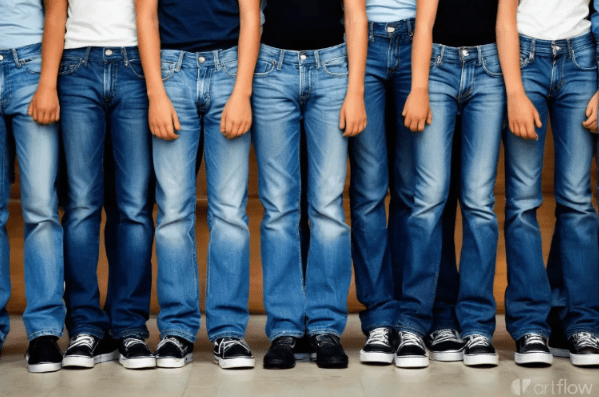Blue Jean Stigma
There are over 14,010 international schools in the world, and each with an impressive 3.8 million enrolled students, ranging from 3-18 years old. A whopping 75% of schools have a requirement for uniforms. Could schools implement these policies to fight against unproductivity? Or could they use them to inhibit students’ self-expression and turn them all into sheep? Blue jeans have been a staple in everyday wear across international schools worldwide. They’re comfy, tough, and can handle many types of activities on campus.
They’re perfect for everything from English class to PE. Accessibility isn’t an issue, because they’re affordable. They’re perfect for any occasion.
Dressing down can help everyone feel like they belong. With ICSA’s mission of “cultivating a sense of belonging and promoting personal growth through relationships,” why not incorporate that into our community?
Comfort is Key
Blue jeans promote diversity, while also promoting unity on campus. Students could be unified in wearing blue jeans, but have the ability to self-express through different styles and colors. One common misconception that certain people seem to have against wearing non-uniform at school is that they invoke hostile competition between students, as was stated by Mr. Pontius in an interview,
“Free-dress policies in schools can sometimes fuel unhealthy competition, shifting focus from learning to appearances and creating unnecessary pressure among students…”
Jeans are the most owned clothing item globally, and people can find them easily, often at low prices. Almost everyone owns a pair, allowing the average population to wear similar outfits that emphasize their shared characteristics. At the same time, people can showcase their unique tastes and personalities by styling their jeans differently. Students, for example, can maintain their sense of belonging by wearing the school uniform shirt while adding appropriate accessories to personalize their outfits and express their individuality.
However, many older generations view blue jeans as unprofessional and unsuitable for a school setting.
I, however, think that as times change, so do the dress standards.
Historical connection
Picture this: less than 100 years ago, it was uncommon to see a female dress in pants or shorts outside of the beach. If you compare it to today, where there are millions of shops designed to cater to the needs of female pants, it’s almost unimaginable.
Blue jeans may have once been reserved for casual settings, but their versatility and multi-use nature make it wasteful not to incorporate them into more formal settings. They are not only visually appealing, but also easy to style with a variety of clothing. No matter what you choose to wear, you can enhance your outfit with a pair of blue jeans.
Consider this: if blue jeans are so unprofessional, why do so many teachers wear them daily at school? Teachers don’t appear unprofessional when they teach; to us, they simply look like teachers.
Certain clothes carry specific connotations, such as swimwear being associated with swimming. However, blue jeans are so versatile that they cannot be limited to one particular place, time, or purpose.
Allowing students to dress like people, just as teachers do, would be highly beneficial.
Unnecessary competition
Why would students struggling financially have to go through the burden of getting already expensive school uniforms, when they could get double the amount of clothes in jeans, for half the price?
Students struggling financially should not have to bear the burden of purchasing expensive school uniforms. Having attended several international schools with and without uniforms, I have seen that students typically don’t get bullied for wearing “cheaper” jeans. On the other hand, I have witnessed bullying over how students wear their school uniforms. It’s hard to stay productive when you feel unattractive and are forced to wear clothes you dislike.
If we gave students a bit more leniency to be able to keep up with certain trends and styles in moderation, the cases of people getting teased for their clothes would drastically decrease.
There could be cases where certain people get teased for their fashion choices, but just as any other opinion based choice, it’s completely subjective.
At all schools, it’s impossible to completely get rid of all forms of bullying. Even with bullying prevention and awareness, it is still inevitable.
ICSA is an international school, a melting pot of different cultures, social classes, and personalities. With so many people, with such different experiences, bullying, in my opinion, is rare.
Disclaimer:
Even though we still aren’t allowed to wear blue jeans at ICSA, student voices are always welcome.
Though we must still abide by the dress code and follow the set uniform standards at school, we’ve been encouraged to re-write the dress code to include blue jeans.
As a student body, we should strive to actually work on policy change. Student voice matters, but don’t forget to follow the rules as well.
For fun ways to bend the dress code a bit, check out this article by Timi Bello.



This is so well written!
Amazing article!!
Such a well written article! Awesome job!